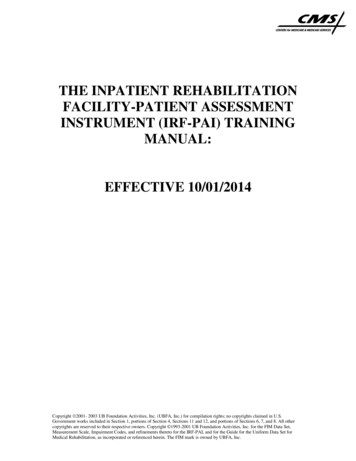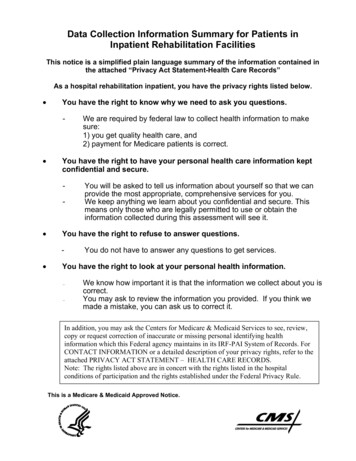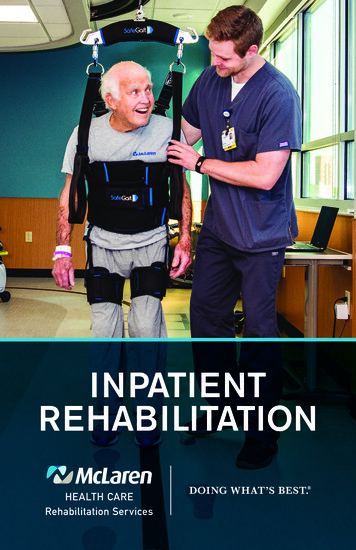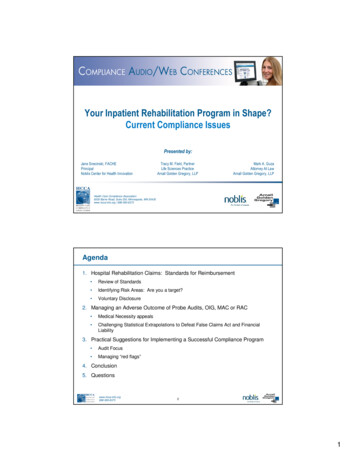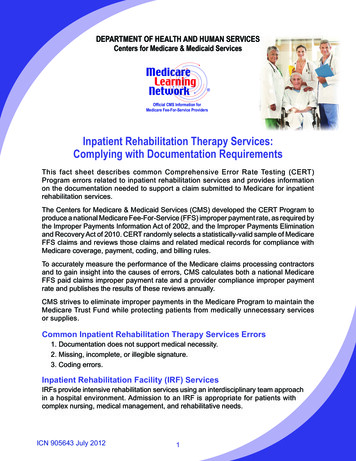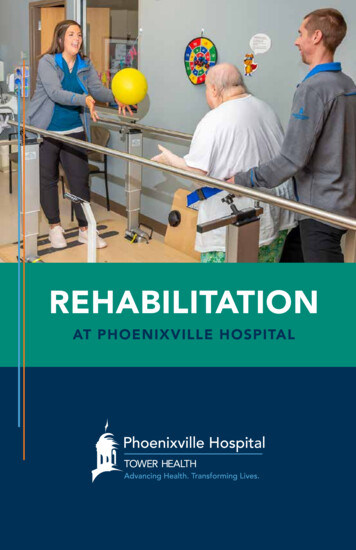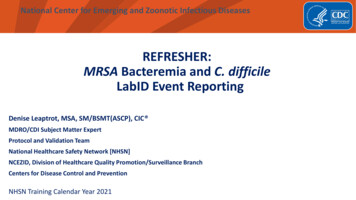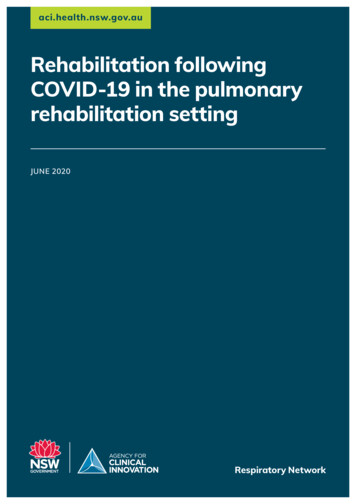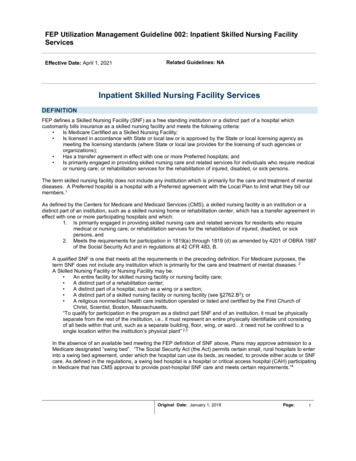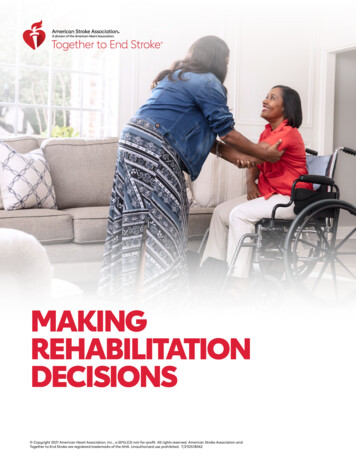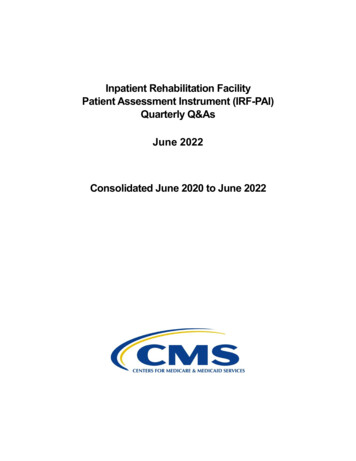
Transcription
Inpatient Rehabilitation FacilityPatient Assessment Instrument (IRF-PAI)Quarterly Q&AsJune 2022Consolidated June 2020 to June 2022
IntroductionThe Centers for Medicare & Medicaid Services (CMS) is publishing the Inpatient RehabilitationFacility Patient Assessment Instrument (IRF-PAI) Quarterly Q&As, so that all IRF providers havethe benefit of the clarifications to existing guidance. Through inquiries to the IRF Post-Acute Care(PAC) Quality Reporting Program (QRP) Help Desk, CMS identifies the opportunity to clarify orrefine guidance.CMS has updated the Quarterly Q&A document in light of the release of the CMS IRF-PAI 4.0Manual on April 1, 2022, effective October 1, 2022. In light of the update, CMS has archivedQ&As reflected in the IRF-PAI 4.0 Manual, and where items are not in the IRF PAI 4.0.The archived Q&As can be found in the IRF Quality Reporting Archives found rting/IRF-Quality-Reporting-ArchivesNew Q&As Added in June 20221. C0600Question 22. GG0130AQuestion 43. GG0170M, GG0170N, GG0170OQuestion 34. H0350Question 3This document is intended to provide guidance on IRF-PAI questions that were received by CMS help desks.Responses contained in this document may be superseded by guidance published by CMS at a later date.IRF-PAI Quarterly Q&As, June 2022, Consolidated June 2020 to June 2022Page i of iii
Consolidated Table of ContentsIntroduction . iNew Q&As Added in June 2022 . iQuality Indicators (QI): General Questions . 1Section A: Administrative Information . 225A, 26A . 225A . 244D . 2Section C: Cognitive Patterns . 3Brief Interview for Mental Status (BIMS) C0100, C0200, C0300, C0400, C0500 . 3C0600 . 3Section GG: Functional Abilities and Goals . 4GG0100C . 4GG0100C, GG0170M, GG0170N, GG0170O . 4GG0100, GG0110 . 4GG0110 . 4GG0130, GG0170 . 5GG0130A . 8GG0130B . 8GG0130C . 9GG0130E . 9GG0130F, GG0130G, GG0130H. 10GG0130G, GG0130H. 10GG0130G . 10GG0130H . 10GG0170 . 11GG0170C . 11GG0170E . 11GG0170F . 12GG0170G . 13GG0170I, GG0170J, GG0170K, GG0170L. 14GG0170I . 15This document is intended to provide guidance on IRF-PAI questions that were received by CMS help desks.Responses contained in this document may be superseded by guidance published by CMS at a later date.IRF-PAI Quarterly Q&As, June 2022, Consolidated June 2020 to June 2022Page ii of iii
GG0170M, GG0170N, GG0170O . 16GG0170M. 16GG0170N, GG0170O. 17GG0170P . 17GG0170Q . 18GG0170R, GG0170S . 18GG0170S . 18Section H: Bladder and Bowel . 19H0350 . 19H0400 . 19Section M: Skin Conditions . 20M0210, M0300 . 20M0300 . 20Section N: Medications . 21N2005 . 21This document is intended to provide guidance on IRF-PAI questions that were received by CMS help desks.Responses contained in this document may be superseded by guidance published by CMS at a later date.IRF-PAI Quarterly Q&As, June 2022, Consolidated June 2020 to June 2022Page iii of iii
Quality Indicators (QI): General QuestionsQuestion 1: Archived June 2022Question 2: Archived June 2022This document is intended to provide guidance on IRF-PAI questions that were received by CMS help desks.Responses contained in this document may be superseded by guidance published by CMS at a later date.IRF-PAI Quarterly Q&As, June 2022, Consolidated June 2020 to June 2022Page 1 of 21
Section A: Administrative Information25A, 26AQuestion 1: Archived June 2022Question 2: If a patient’s height and/or weight was not measured within the 3-day admissionassessment period for 25A - Height on admission and 26A - Weight on admission, is it okayto use a height and/or weight that was measured day 5?Answer 2: In order to be compliant, the admission assessment must be completed by the end ofthe 3-day assessment period (i.e., midnight of the third calendar day). If a patient’s height and/orweight cannot be measured during the 3-day assessment period, enter a dash (–) to indicate “noinformation” for 25A - Height on admission and/or for 26A - Weight on admission. CMS expectsdash use to be a rare occurrence.Added: June 202125AQuestion 1: Archived June 202244DQuestion 1: Archived June 2022Question 2: A patient who was admitted to IRF was planning on being discharged to a SNFon 2/14/22 however prior to discharge the patient was sent to the emergency department(ED). The ED then discharged the patient home with home care services the following day,on 2/15, rather than sending them to the SNF. How do we code 44D - Discharge Dispositionfor this scenario?Answer 2: When a patient is transported from the IRF to an emergency department (ED) orobservation status, and they do not return to the IRF within 3 days, complete a dischargeassessment and code the discharge destination as the first subsequent provider setting the patientis admitted to immediately following the ED and/or observation stay. If a patient remains in EDand/or observation status for 3 days, code the discharge destination as Code 99 - Not listed.A subsequent provider is defined as a short-term general hospital, a SNF, intermediate care,home under care of an organized home health service organization or hospice (home), hospice inan institutional facility, an IRF, an LTCH, a Medicaid nursing facility, an inpatient psychiatricfacility, or a Critical Access Hospital (CAH).In the scenario, if the patient was transported from the IRF to an ED and within 3 days isdischarged home from the ED to receive home care from a Medicare-certified home healthagency, code 06 - Home under care of an organized home health service organization.Added: March 2022This document is intended to provide guidance on IRF-PAI questions that were received by CMS help desks.Responses contained in this document may be superseded by guidance published by CMS at a later date.IRF-PAI Quarterly Q&As, June 2022, Consolidated June 2020 to June 2022Page 2 of 21
Section C: Cognitive PatternsBrief Interview for Mental Status (BIMS) C0100, C0200, C0300, C0400, C0500Question 1: Archived June 2022Question 2: Archived June 2022C0600[NEW] Question 1: Please clarify how C0600 - Should the Staff Assessment for Mental Status(C0900) be coded when C0100 - Should Brief Interview for Mental Status (C0200-C0500) beConducted? is coded as 0 - No.Answer 1: When C0100 - Should Brief Interview for Mental Status (C0200-C0500) beConducted? is coded as 0 - No, skip C0200 - C0600.Added: June 2022This document is intended to provide guidance on IRF-PAI questions that were received by CMS help desks.Responses contained in this document may be superseded by guidance published by CMS at a later date.IRF-PAI Quarterly Q&As, June 2022, Consolidated June 2020 to June 2022Page 3 of 21
Section GG: Functional Abilities and GoalsGG0100CQuestion 1: Archived June 2022GG0100C, GG0170M, GG0170N, GG0170OQuestion 1: Archived June 2022GG0100, GG0110Question 1: We have questions regarding prior level of functioning and prior device use. Apatient is admitted to our facility for rehab, has a medical issue, and is discharged to an acutecare hospital for a week. When the patient returns to our facility, would the prior level offunctioning reported in GG0100B - Prior Functioning: Indoor Mobility reflect the patient’sambulation status prior to the original admission (which is the reason we are still treatingthe patient) or is the prior level of functioning based on what the patient was doing duringthe hospital stay? Would this also apply to GG0110 - Prior Device Use?Answer 1: The intent of GG0100B - Prior Functioning: Indoor Mobility is to report the patient’sneed for assistance with walking from room to room, with or without a device such as a cane,crutch, or walker, prior to the current illness, exacerbation, or injury. The intent of GG0110 - PriorDevice Use is to indicate which devices and aids were used by the patient prior to the currentillness, exacerbation, or injury. The assessing clinician must consider each patient’s uniquecircumstances and use clinical judgment to determine how prior functioning and prior device useapply for each individual patient.In responding to GG0100 - Prior Functioning: Everyday Activities, the activities should bereported based on the patient’s usual ability prior to the current illness, exacerbation, or injury.This is the patient’s functional ability prior to the onset of the current illness, exacerbation of achronic condition, or injury, whichever is most recent, that initiated this episode of care. Cliniciansshould use clinical judgment within these parameters in determining the timeframe that isconsidered “prior to the current illness, exacerbation, or injury.”The same approach should be used in determining Prior Device Use for GG0110.Added: September 2020GG0110Question 1: Archived June 2022This document is intended to provide guidance on IRF-PAI questions that were received by CMS help desks.Responses contained in this document may be superseded by guidance published by CMS at a later date.IRF-PAI Quarterly Q&As, June 2022, Consolidated June 2020 to June 2022Page 4 of 21
GG0130, GG0170Question 1: Archived June 2022Question 2: Archived June 2022Question 3: I am seeking clarification on how to accurately code the admission assessmentsfor Section GG0130 Self-care and GG0170 Mobility when a patient leaves AMA before theadmission assessment is completed.Would it be appropriate to use Code 07 - Patient refused if an assessment was not donebecause of the patient leaving AMA?Answer 3: Patients who meet the criteria for incomplete stays include patients who are dischargedto an acute care setting (such as short-stay acute hospital, critical access hospital, inpatientpsychiatric facility, or long-term care hospital), patients who die while in the IRF, patients wholeave the IRF against medical advice (AMA), and patients with a length of stay less than 3 days.If the patient’s IRF stay is less than 3 days, and ends before the admission assessment wascompleted, code GG0130 and GG0170 performance to the best of your abilities. If the patientrefused rehab at the IRF and left AMA before the admission assessment was completed, use Code07 - Patient refused.Added: June 2020Question 4: Archived June 2022Question 5: Archived June 2022Question 6: We understand that if a patient initially refuses to attempt an activity during theassessment period, but later agrees to perform the activity, the code that represents thepatient’s actual performance supersedes the refusal code (07). What if on day 1 or day 2 asafety or medical issue prevents the patient from attempting an activity, but on day 3, afterbenefiting from therapeutic intervention, the patient can now perform the activity? Whichcode should be reported on the IRF-PAI: Code 88 - Not attempted due to medical conditionor safety concerns, or one of the performance codes, 01-06?Answer 6: At Admission, the self-care or mobility performance code is to reflect the patient’sbaseline ability to complete the activity, prior to the benefit of services provided by your facilitystaff. “Prior to the benefit of services” means prior to provision of any care by your facility staffthat would result in more independent coding.Use of an “activity not attempted” code should occur only after determining that the activity is notcompleted prior to the benefit of services, and the performance code cannot be determined basedon patient/caregiver report, collaboration with other facility staff, or assessment of similaractivities.This document is intended to provide guidance on IRF-PAI questions that were received by CMS help desks.Responses contained in this document may be superseded by guidance published by CMS at a later date.IRF-PAI Quarterly Q&As, June 2022, Consolidated June 2020 to June 2022Page 5 of 21
If this is the case in your scenario, code 88 - Not attempted due to medical condition or safetyconcerns even if the patient’s status changes and the patient is able to complete the activity on alater day during the assessment period.Added: September 2020Question 7: Archived June 2022Question 8: How should the following situation be coded for the GG0130 - Self-Care andGG0170 - Mobility items? On discharge a patient was nonadherent with spinal precautions.The patient was able to demonstrate completing functional tasks independently with goodbalance and strength, and was cognitively intact. By the patient’s report, they were choosingnot to routinely adhere to spinal precautions in their day-to-day activities, although theywere aware of the precautions and risks. Should the GG activities be coded based on thepatient’s ability, which is independent, or based on the fact that they knowingly break theirprecautions?Answer 8: The GG activities focus on the patient’s ability to complete the activities asindependently as possible as long as they are safe; willingness and nonadherence are not the focusof the coding.If, in your scenario, you have assessed the patient being able to independently complete the GGactivities safely, code 06 - Independent.Added: June 2021Question 9: For GG0130 - Self-Care and GG0170 - Mobility, it is our facility’s policy that apatient always have a staff member present during walking or toileting activities. Is itpossible for the GG activity to be assessed and coded 06 - Independent, for situations wherea staff member is required to be present per facility policy, but is not required to assist orsupervise the patient in any way?Answer 9: When assessing self-care and mobility activities, allow the patient to complete eachactivity as independently as possible, as long as he/she is safe.If a helper is present (only due to facility policy) code the activity based on the type and amountof assistance the patient requires to complete the activity as independently as possible, as long asthey are safe. If no assistance/supervision/set-up is required, then code 06 - Independent.Added: September 2021This document is intended to provide guidance on IRF-PAI questions that were received by CMS help desks.Responses contained in this document may be superseded by guidance published by CMS at a later date.IRF-PAI Quarterly Q&As, June 2022, Consolidated June 2020 to June 2022Page 6 of 21
Question 10: When determining the appropriate performance code at admission for the GGself-care and mobility activities there are times when the score on day 1 differs from thescores on days 2 and 3. For example: On Day 1 when attempting to perform a sit to stand transfer, even with assist fromthe therapist the patient is unable to complete the transfer due to pain. The therapistscores GG0170D - Sit to stand as a Code 88 - Not attempted due to medical conditionor safety concerns in day 1 notes. On day 2, per therapy notes the patient was able tocomplete the sit to stand transfer with assistance of two people. Which code would Iuse? Code 88 - Not attempted due to medical condition or safety concerns or Code 01- Dependent? On Day 1 there is no mention of sit to stand noted in documentation. On day 2documentation reports that the patient requires partial/moderate assistance of 1(Code 03) and later that day the therapy note shows that the patient required theassistance of two people to stand. How would this scenario be coded? Does any sourcetake priority? Do I look at all three days and select usual performance from allsources?Answer 10: At Admission, the self-care or mobility performance code is to be based on afunctional assessment that occurs at or soon after the patient’s admission, and reflects the patient’sbaseline ability to complete the activity prior to the benefit of services provided by your facilitystaff.“Prior to the benefit of services” means prior to provision of any care by your facility staff thatwould result in more independent coding.When the baseline function code differs from the usual performance during the assessment period,report the baseline function code.If in your first scenario, the patient being unable to complete the sit to stand activity due to medicalconditions or safety concerns represents their baseline ability, then code 88 - Not attempted due tomedical condition or safety concerns.In your second scenario, as in all admission scenarios, select the code that represents the patient’sbaseline ability to complete the activity as independently as possible as long as they are safe, priorto the benefit of services provided by your facility staff.Added: December 2021This document is intended to provide guidance on IRF-PAI questions that were received by CMS help desks.Responses contained in this document may be superseded by guidance published by CMS at a later date.IRF-PAI Quarterly Q&As, June 2022, Consolidated June 2020 to June 2022Page 7 of 21
GG0130AQuestion 1: Archived June 2022Question 2: A patient is admitted to an Inpatient Rehabilitation Facility (IRF) withquadriparesis from a previous spinal cord injury. Once an occupational therapist applies auniversal cuff to the patient’s hand, the patient is able to eat the entire meal without furtherassistance. What is the performance code for GG0130A - Eating?Answer 2: The intent of GG0130A - Eating is to assess the patient’s ability to use suitable utensilsto bring food and/or liquid to the mouth and swallow food and/or liquid once the meal is placedbefore the patient.In the scenario provided, if the patient only requires assistance to apply a universal cuff and nofurther assistance is required during the eating activity, then code 05 - Setup or clean-up assistance.This is because assistance is only required prior to or following the activity, but not during theactivity.Added: December 2020Question 3: Archived June 2022[NEW] Question 4: A patient is independent with self-feeding, but requires encouragementfor adequate intake. Would the encouragement to increase food and/or fluid intake beconsidered when scoring GG0130A - Eating?Answer 4: The intent of GG0130A - Eating is to assess the patient’s ability to use suitable utensilsto bring food and/or liquid to the mouth and swallow food and/or liquid once the meal is placedbefore the patient. The adequacy of the patient’s nutrition or hydration is not considered forGG0130A - Eating.When coding activities in Section GG, clinicians should code based on the type and amount ofassistance required allowing the patient to perform the activity as independently as possible, aslong as they are safe. If the patient is able to meet the intent of the activity with no assistance(physical, verbal/nonverbal cueing, setup/clean-up) then code 06 - Independent.Added: June 2022GG0130BQuestion 1: Archived June 2022This document is intended to provide guidance on IRF-PAI questions that were received by CMS help desks.Responses contained in this document may be superseded by guidance published by CMS at a later date.IRF-PAI Quarterly Q&As, June 2022, Consolidated June 2020 to June 2022Page 8 of 21
GG0130CQuestion 1: Archived June 2022Question 2: Archived June 2022Question 3: Archived June 2022Question 4: I understand that if a helper provides setup before toileting hygiene or clean-upafter, and the patient completes the activity of toileting hygiene without additional assistance,the correct code is 05 - Setup or clean-up assistance.What would the correct code be if a helper provided assistance (contact guard or touchingassistance) to the patient as the patient gathered their incontinence products but then thepatient completed the toileting hygiene activity without further assistance?Answer 4: The intent of GG0130C - Toileting hygiene is to assess the patient’s ability to maintainperineal hygiene and adjust clothes (including undergarments and incontinence briefs) before andafter voiding or having a bowel movement.It is not the type of assistance that is provided that determines the 05 - Setup or clean-up assistancecode but rather when (related to the completion of the activity) the needed assistance is provided.If the assistance provided is necessary only before or after the activity is completed, and noassistance is needed during the completion of the activity, select Code 05 - Setup or clean-upassistance.Added: December 2021GG0130EQuestion 1: Archived June 2022Question 2: Archived June 2022Question 3: For a patient who stood while showering prior to this illness, should we now beassessing and scoring showering/bathing based on the patient’s status standing?Answer 3: The intent of GG0130E - Shower/bathe self, is to assess the patient’s ability to batheself, including washing, rinsing, and drying self (excludes washing of back and hair). The activitydoes not include transferring in/out of tub/shower.When coding any of the self-care or mobility activities in Section GG, clinicians should code whatoccurs at the time of the assessment and allow the patient to perform the activity as independentlyas possible, as long as the patient is safe, regardless of how the patient performed the activity priorto the current illness, exacerbation, or injury.Added: June 2020This document is intended to provide guidance on IRF-PAI questions that were received by CMS help desks.Responses contained in this document may be superseded by guidance published by CMS at a later date.IRF-PAI Quarterly Q&As, June 2022, Consolidated June 2020 to June 2022Page 9 of 21
Question 4 and 5: Archived June 2022GG0130F, GG0130G, GG0130HQuestion 1: Archived June 2022GG0130G, GG0130HQuestion 1: Archived June 2022GG0130GQuestion 1: Archived June 2022GG0130HQuestion 1: Archived June 2022Question 2: We have a question regarding the following scenario. On day 2 of the patient’sstay, the occupational therapist (OT) evaluates and assesses all the GG self-care activities.During that evaluation, for footwear, the patient only dons hospital socks (regular shoes andsocks are not available) and requires only cueing. Toward the end of the session (after theassessment), the OT initiates the intervention of ADL re-training. On day 3, after theinitiation of ADL re-training, the patient’s spouse brings in socks and tennis shoes with laces,which are the patient’s preferred footwear. The patient now requires greater than 50%assistance of one helper for donning footwear. Even though it is post intervention, can the“greater than 50% assistance” score be reported since it is still within the assessmenttimeframe?Answer 2: The intent of GG0130H - Footwear is to assess the patient’s ability to put on and takeoff socks and shoes or other footwear that is appropriate for safe transfer and/or ambulation(mobility), including fasteners (if applicable).When assessing self-care and mobility activities, allow the patient to complete each activity asindependently as possible, as long as they are safe.At Admission, the self-care or mobility performance code is to reflect the patient’s baseline abilityto complete the activity, prior to the benefit of services provided by your facility staff.Clinicians should use clinical judgment to determine if observing the patient putting on and takingoff the footwear (i.e., hospital socks) worn during the first assessment allows the clinician toadequately assess the patient’s baseline ability to complete the activity of putting on/taking offfootwear (GG0130H). If the clinician determines that this observation is adequate, code based onthe type and amount of assistance required to complete the activity.Added: September 2020This document is intended to provide guidance on IRF-PAI questions that were received by CMS help desks.Responses contained in this document may be superseded by guidance published by CMS at a later date.IRF-PAI Quarterly Q&As, June 2022, Consolidated June 2020 to June 2022Page 10 of 21
GG0170Question 1: Archived June 2022Question 2: If a patient is dependent for all GG bed mobility activities would it be acceptableto code the patient as dependent for all other GG mobility activities even if those activitieswere not specifically assessed?Answer 2: At Admission, the mobility performance code is to reflect the patient’s baseline abilityto complete the activity, and is based on observation of activities, to the extent possible. Cliniciansmay assess the patient’s performance based on direct observation (preferred) as well as reportsfrom the patient and/or family, assessment of similar activities, collaboration with other facilitystaff, and other relevant strategies to complete all GG items.Each IRF-PAI item should be considered individually and coded based on the guidance providedfor that item.It is important to determine whether the appropriate code for each GG activity is a performancecode (including 01 - Dependent)
an institutional facility, an IRF, an LTCH, a Medicaid nursing facility, an inpatient psychiatric facility, or a Critical Access Hospital (CAH). In the scenario, if the patient was transported from the IRF to an ED and within 3 days is discharged home from the ED to receive home care from a Medicare-certified home health
